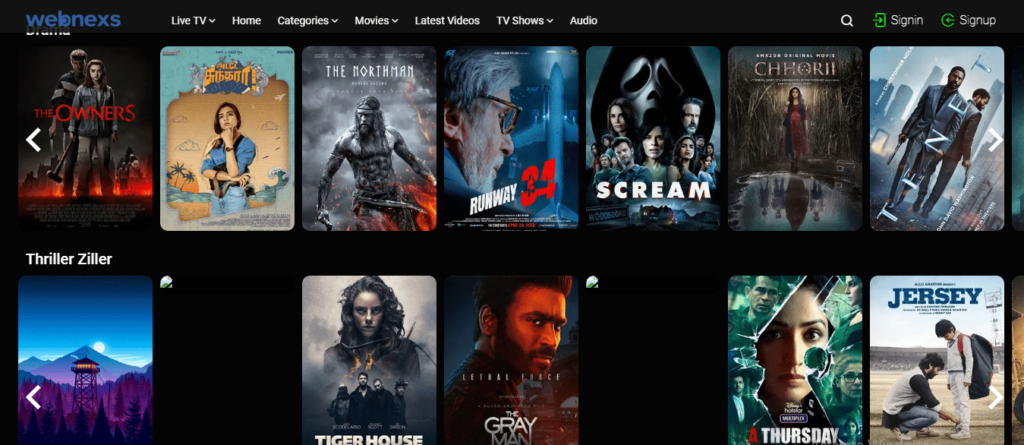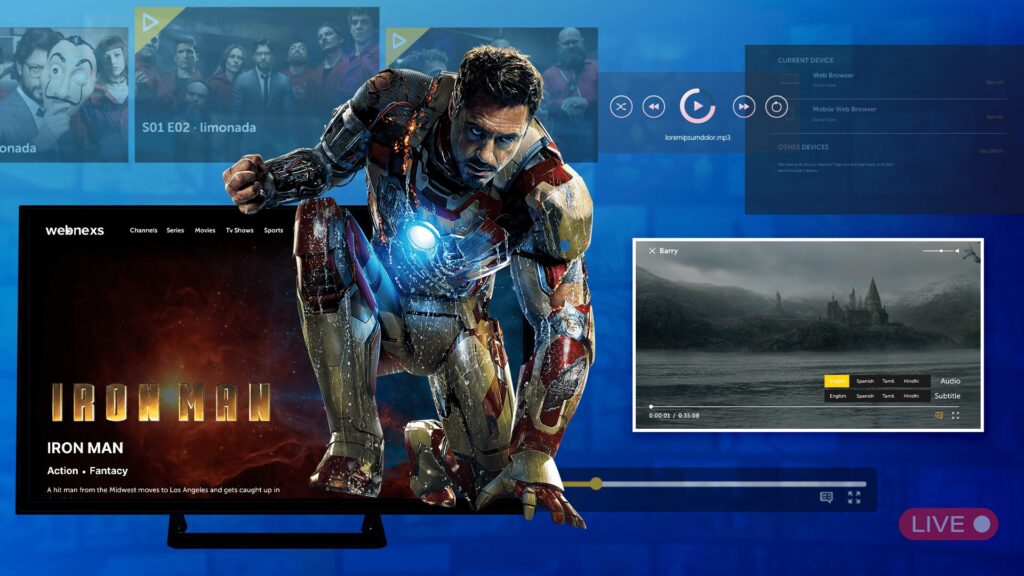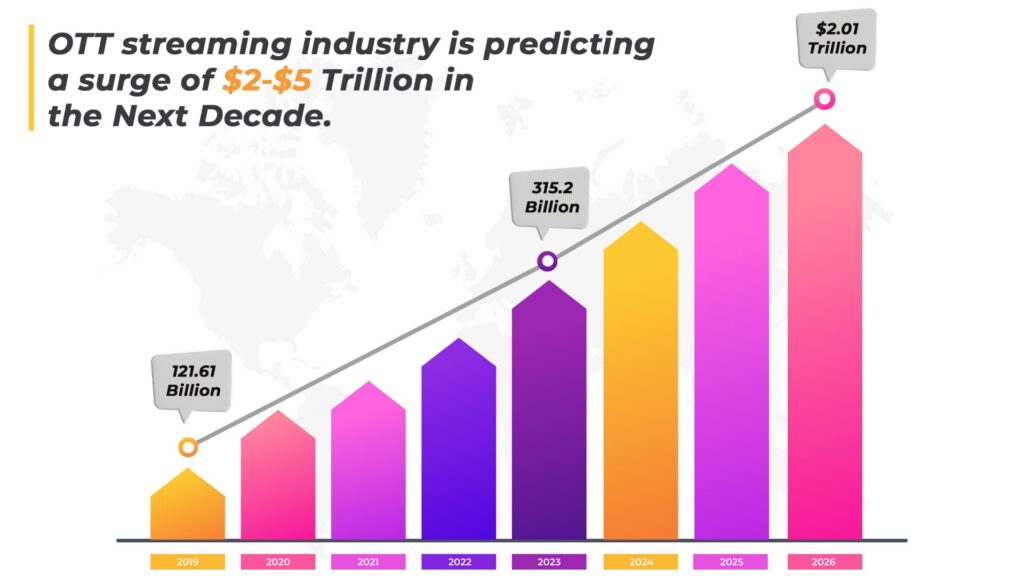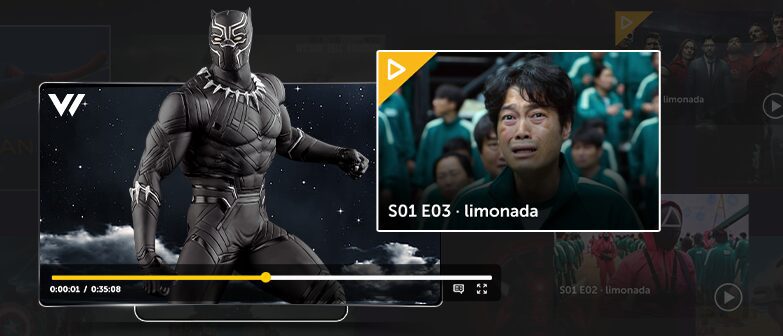OTT has rapidly gained popularity as a compelling alternative to traditional cable television programming, capturing the attention of a wide audience.
This cutting-edge trend of OTT platform streaming has garnered significant enthusiasm among teenagers, primarily because of its vast selection of new web series, TV shows, and even interactive gaming experiences.
The essence of OTT lies in the ability to access preloaded television episodes or any other form of OTT content with no limitations on the number of views. All of this captivating content is meticulously organized within a comprehensive and centralized library, encompassing movies in multiple languages.
Now, with this intriguing introduction, you may be eager to delve deeper into the true meaning and significance of “OTT,” right?
Well, folks.., the moment has arrived for us to unveil this captivating subject that represents the future of entertainment—an evolution that is already well underway.
If you’re curious to learn more about Over the top and how it’s shaping the future of television, you’re in the right place. In this article, we will provide a comprehensive guide to everything you need to know about OTT, from its definition and benefits to its drawbacks.
What is OTT?
We define any online content provider that offers streaming media as a separate product or service as an OTT media service. This term is commonly used for video-on-demand platforms, but it can also include audio streaming or real-time platform streaming solutions.
OTT platform avoids traditional media distribution channels such as telecommunications networks and cable TV providers. One of the advantages is that you can access the full service at any time, or let your users download videos and watch them offline. All you need is a stable internet connection, either locally or through a mobile network. get started.
What is the Meaning Of OTT
The term OTT means “Over-The-Top,” which refers to surpassing the conventional modes of entertainment delivery, such as YouTube and social media. The mighty OTT industry offers a remarkable enhancement in the realm of entertainment. It provides access to content that can be watched on computers and various OTT devices, offering a notable shift from regular viewing to a premium, high-quality experience. This is made possible through the utilization of wireless internet connectivity, delivering captivating and visually immersive experiences.
Here’s a breakdown of how OTT media technology operates:
- Firstly, media broadcasters upload their video content to an over-the-top (OTT) streaming service.
- The video data is then transmitted through remote servers via seamless CDN (Content Delivery Network) networks.
- Subsequently, viewers can explore a diverse range of content options from the user-end video gallery and stream their desired selections.
Finally, using an HLS (HTTP Live Streaming) video player on their device, viewers can pull the video content from the CDN’s video streaming server via the internet, enabling smooth distribution and playback
How does OTT work?
The decision to opt for OTT streaming over traditional methods of entertainment delivery heavily relies on the presence of a robust video delivery environment that matches or surpasses conventional standards. One of the noticeable drawbacks of serving TV content in a stereotypical manner is its limited adaptability to varying network performances.
The functioning of OTT services involves a unique approach aimed at mitigating the impact of such limitations. By leveraging OTT technology, content distribution is tailored to adjust dynamically to the network performance throughout the transmission chain, eliminating the need for buffering interruptions.
In an ideal scenario, during periods of stable network connectivity, the advanced player expects and buffers additional content in advance, ensuring smooth playback even during network instability. This is made possible through implementing Adaptive Bitrate Rate technology, which optimizes streaming across a wide range of devices such as Roku, Firestick, Apple TV, Android TV apps, and laptops.
Understanding About OTT?

OTT platform is more than just YouTube and social media. It adds a new level of entertainment to the industry. You can watch OTT content on computers and other devices. Using the term “premium” instead of “normal” for high-quality viewing makes a big difference. Over the top provides more experiences through wireless internet, premium content, and high-quality viewing.
Read More: Top Suggestions for OTT Broadcasting in 2022
What is OTT delivery?
The entertainment is available at all times is one of the main reasons for its popularity. To watch your exclusive content, customers only need a high-speed internet connection and a connected device that can operate apps or browsers, which are finely developed through OTT app development. There are a variety of technologies that may entice wider segments of the audience.
OTT Devices for Mobile
Users can download OTT apps to enjoy entertainment on-the-go on smartphones and tablets using high-quality streaming versions.
PCs are personal computers.
OTT technology has no geographical limits, which means consumers can access content from anywhere in the world using desktop apps or web browsers.
Smart televisions
Signing in to your individual account on the OTT media platform has never been easier! As a result, you may access your OTT subscriptions from anywhere at home using devices like Roku, Apple TV, or Fire Stick.
Read our webstories : What is ott and its benefits
Why is OTT Better Than YouTube?
Better Quality Content
Video streaming services offer better quality content than YouTube. Unlike YouTube, streaming services are subscription-based, which means they have access to more exclusive content. OTT services produce their own content, which is usually of a higher quality than the content found on YouTube.
Ad-free Experience
OTT services give you the option to watch without ads, which is not available on YouTube. This means that when you watch shows and movies on an Over the top service, you won’t be interrupted by ads like you might be on YouTube, which could affect your enjoyment of the content.
Personalized Recommendations
It offers personalized instruction based on your viewing history. This means that you will discover new content that you will enjoy watching. YouTube offers recommendations, but they are not as accurate as those provided by OTT services.
User Interface
OTT services have a simple and easy-to-use interface that is straightforward to navigate. They can complicate YouTube for people who are not familiar with it. With OTT services, you can find the content you’re looking for with no trouble and in a timely manner.
Better Streaming Quality
Over the top services provide better video quality streaming compared to YouTube. They are made to give you a top-notch viewing experience with fewer pauses for buffering. In contrast, YouTube can have more buffering, which can be annoying, especially when you’re trying to watch movies or TV shows.
Read More: 6 Necessary Tips to Optimize Your OTT Platform Strategy in 2022
Some examples of how OTT media technology works

Media technology has changed the way we consume and distribute media, making streaming seamless for viewers. Here are some examples of how media technology is being used and how it’s changing the industry.
Video Streaming
They widely used OTT media technology for video streaming services like Netflix, Hulu, and Amazon Prime. This technology allows users to watch their favorite TV shows, movies, and other content on-demand, at any time and from any location. Streaming services use data analytics to personalize the viewing experience, which enhances the user’s enjoyment.
Live Streaming
The low latency and high-quality streaming make it an excellent option for delivering live content to viewers in real-time. Popular live-streaming services include YouTube TV, Sling TV, and PlayStation Vue.
Advertisers
Brands can use this technology to show targeted ads to users based on their viewing habits and preferences. Media technology also provides detailed metrics to measure how effective campaigns are, which makes it a more affordable choice for marketers.
Read More: 8 Marketing Tools that will Help You Boost Your OTT Platform
Education
Over the top media technology is now being used in education to create a more interesting and interactive learning experience for students. Educational institutions can use this technology to provide high-quality videos, online courses, and tutorials to students, no matter where they are located.
To begin, media companies submit video content to an (over-the-top) video platform.
Read More : Top 5 Traits That Develop An E-learning Platform More Associated?
Following that, they send video data via CDN Networks to remote servers.
Later on, your visitors can choose from a variety of content options on the user-end video gallery and stream.
Finally, the HLS video player on the device downloads video content from a CDN’s server over the internet and distributes it.
Let’s look at how OTT videos are distributed now.
Read More : All About OTT: A Comprehensive Overview
Benefits of creating OTT content.?
Take Command & Control
This means that when you launch using Over the top, you have full control over your creative content, branding, user experience, audience analytics, revenue, and other data. This is not possible on YouTube.
Boost Your Efforts with Ad-Free Content
With subscription services supporting digital campaigns, targeted OTT advertising, and direct sponsorships, it has offered the most possibilities for showing ad-free content.
Direct Approach to the Consumer
If your viewers ask what OTT means and how it can benefit them, you can tell them that it’s the best way to share great information with their target audience. Using OTT, they can provide a top-notch VOD experience that they control. This will help them engage their audience better and get quick feedback.
Live Streaming Is a Sure-Fire Winner
Live streams are the basic definition of an OTT platform and its beneficiaries. By using Over thr top platforms to distribute and sell live content, you can offer your audience a great viewing experience.
Read more: What are the Benefits of OTT Platforms
Top 5 exciting OTT business opportunities to explore
OTT media technology has created new opportunities for businesses in various industries. Companies can use this technology to provide streaming services, create content, advertise products and services, and educate audiences.

Almost half of the people in North America are using over-the-top services, which makes it the highest region in usage. This has caused broadcast networks like ABC and CBS to lose viewers and they are now thinking of new ways to market and deliver their content.
Read More: Over-The-Top (OTT) Market is Expected to Reach USD 175 Billion by 2026
Here are the top five exciting OTT business opportunities to explore.
People want videos that are made just for them, and OTT technology can help companies do that. Making a video service for one kind of thing or interest can help companies stand out. By creating a streaming service, these companies can make better suggestions about what videos to watch next. This makes the watching experience even better for people.
OTT technology provides advanced metrics, enabling businesses to accurately measure the effectiveness of their advertising campaigns. Advertisers can utilize this technology to deliver personalized and highly targeted ads to users based on their viewing habits and preferences. By investing in innovative and creative ad campaigns, businesses can effectively capture the attention of viewers and build brand awareness.
Read More: How Sports OTT platforms Changing Streaming Industry in 2022
New Revenue Streams: Businesses can generate additional sources of revenue through various models such as subscription-based, pay-per-view, and ad-based models. By leveraging this technology, businesses can monetize their content and create new revenue streams, while providing viewers with high-quality, on-demand content.
Educational institutions can leverage OTT technology to develop interactive and engaging educational content for their students. By delivering high-quality video content, online courses, and tutorials, educational institutions can reach a broader audience, regardless of their location.
OTT technology allows for personalized learning experiences, providing students with the flexibility to learn at their own pace.
HD Streaming: Companies can display videos that are visually impressive and can be easily accessed without delay. This makes it more fun to watch and people can do things like ask questions while they watch.
This is a good chance for businesses to get more people to know about them and what they do.
What are the key challenges of OTT to consider?
Knowing all of these things will help you understand more about the subject. This will help you make good choices that match what your brand wants to do.

Here are some subjects to consider:
- When sharing videos with lots of people, it can be hard to keep the video quality high. But using special tools can help.
- OTT technology enables people to view videos through various websites and internet connections, providing a diverse range of options for accessing content.This can make problems happen, but using special tools can help find and fix them.
- OTT providers must prioritize seamless video functionality since users are more likely to stop using a service that experiences technical difficulties..
- Live videos are even harder to share because they need to work on lots of different devices and internet connections.
- OTT providers require specialized tools to ensure the smooth functioning of their services by gaining insights into any issues that may arise..
OTT for content providers:
Global reach:
OTT platforms let content creators show their videos to people all around the world without needing the usual TV equipment.
As long as people have the internet, they can watch videos from anywhere in the world. This makes it easy for content creators to get more viewers and become more popular.
Control over content:
OTT platforms let content creators have more power over their videos. They can decide what videos to share, when to share them, and how to show them to people.
Having this control means content creators can make videos that are perfect for certain groups of people. This makes watching videos better for everyone who watches them.
Data and analytics:
OTT platforms give content creators helpful information about their viewers. They can see how people are watching their videos and what they like to watch. This helps them make better videos that people want to see. They can also use this information to decide what to make next.
Monetization options:
OTT platforms give people different ways to make money from their videos. They can choose to make people pay to watch their content, show ads during their videos, or have people pay a monthly fee to access their content. This lets content creators pick the best way to make money from their videos while giving viewers something they want to watch.
Lower costs:
OTT platforms differ from traditional broadcasting because they’re not expensive. They’re a cheap way for people who make videos to share them. This makes it easy for independent creators to share their high-quality content without spending a lot of money.
Brand exposure:
Using OTT platforms to share content lets providers get their brand seen by more people and find new fans. This can help them grow and maybe even find new partners to work with. Overall, it helps them become more important in the industry.
Read More: OTT Video Piracy : How it Can Be Stopped | Webnexs
How Webnexs help for Brands and Creators in OTT
OTT platforms are changing how content creators, brands, and organizations work with digital video content. Before, people would use networks like YouTube to reach a big audience. Now, things are different.
Webnexs has an OTT solution that lets content creators make their own video hub without needing other networks. This way, they can have more control over their content, how it’s shared, and how much it costs. It also helps brands make sure their look and feel matches their identity.
Webnexs is a versatile platform that caters to different content creators, including:
There are different people who want to use personalized video platforms for various reasons.
Independent creators want to make their content better and get more fans.
Creator communities want to show off their talent and get more people interested.
Musicians and artists want to easily live stream their performances to fans around the world.
Film festivals want to sell tickets and work better with creators.
Faith organizations want to bring people together for worship and other services.
Companies and groups want to keep their brand while having a good channel.
At Webnexs, we offer a complete solution to help you make your own unique brand, create content channels, stream live events, and make money with subscriptions and sponsorships. We think it’s important for creators to have complete control over their content and how it’s shared. We’re excited to join you on your journey into the exciting world of OTT.
Read More: The Ultimate Guide to Start Your OTT Platforms in 5 Simple Steps
Future of the OTT industry’s
In 2021, the number of people who watched TV shows and movies through OTT services surpassed those who watched through traditional TV. This significant shift in viewing habits indicates that a growing number of people are opting out of cable or regular TV. Industry experts predict that this trend will continue to increase in the future.
Let’s look at five fascinating statistics:
- The OTT industry’s revenue could reach $273,190 million, and the number of users could rise to 3,777.9 million by 2025, with a global penetration rate of 48.3%.
- Live streaming made up 24% of global OTT viewing in Q1 2021, a 14% increase from the previous quarter.
- Every year since 2013, there has been at least one major global OTT service launch, including Netflix, Disney+, and Amazon Prime Video.
- We expect oTT TV and video subscriptions to reach 2 billion by 2025, a 65% increase from 2020 to 2025.
- Adults spend an average of almost a full work week each month on OTT subscription services (1 hour and 12 minutes per day), with OTT subscribers spending even more time (1 hour and 50 minutes per day).
What’s next? As a TV service provider, there’s no avoiding the surging popularity of OTT video streaming. It’s essential to jump on board the bandwagon and not fall behind. Although competition has increased, with consumers having more video platform options than ever before, there are ways to successfully compete in this market.
Read More: Top OTT Statistics in 2023
To create a great OTT service, first, find unique content like a special group of videos or exclusive local sports events. You could also bring back classic movies. Lots of video content can be successful now! Then, pick a plan for how to make money and share your content with the right people. Finally, choose the technology to make it all happen.
Streaming Goes Global: The Implications of the OTT Industry’s Expansion
The OTT industry is on the rise, and it’s not slowing down soon. In the past, American families would gather around their televisions once a week to watch their favorite shows. But times have changed, and now we have the freedom to stream content on any device. The shift towards on-demand content is a cultural change that is transforming our mindset to prioritize immediate access to content.Cable companies and big networks like ABC and CBS may Struggle to adapt, But they’re not becoming extinct. Instead, they’re finding new ways to market and deliver their content.
Read More: Over-The-Top (OTT) Market is Expected to Reach USD 175 Billion by 2026
The demand for on-demand content is rapidly increasing, and companies are responding by providing digital streaming services through various apps and platforms.In Q1, on-demand video accounted for over three-quarters of all time spent streaming, with a 76% share compared to live video’s 24%. The OTT industry is the future, and companies that cannot adapt may be at risk of being left behind.
OTT features on Webnexs

Completely Customize Your OTT Solution with a White Label
Instead of the hassle and expense of hiring a full-time in-house development team, consider a tailor-made White label OTT solution. This way, you can grow your brand exposure with a one-time cost.
The Power of Live Streaming
When you’re looking for an OTT platform, it’s important to consider live streaming as a valuable feature. By monetizing and sharing live content, you can give your audience an excellent viewing experience.
Read more: Low Latency Streaming Platform: The Complete Guide
Crystal-Clear Cloud Transcoding
Using cloud transcoding, you can launch your own OTT business and stream your movies in different codecs like MPEG-2, AV1, and H.264, with the help of an HTML media player. This ensures that your viewers get a great quality experience when watching your content.
Collaborate with a Content Partner Portal
Working together with leading OTT platforms allows you to showcase your unique content on your platform. By setting OTT pricing with your digital partners, you can put in place measures to control access and monitor user activity.
From Live to VOD
Automatically record live streaming videos on your VOD platform to establish sustainable revenue streams. By offering them as on-demand videos, you can cater to viewers’ real-time viewing preferences.
Read more: Best Video on Demand (VOD) Revenue Models for your Video Streaming Business 2023
Video CMS
The Video CMS feature is important for quickly organizing, managing, and streaming content while on the move. It lets users set up business rules, like scheduling when videos are available in different regions. This creates a great experience for users by providing an easy-to-use interface to navigate through the video library with ease.
Final Thoughts:
In the ever-evolving landscape of fast-paced content moderation, the digital streaming infrastructure has emerged as a lifeline. It proves to be particularly advantageous for broadcasters, video publishers, and content owners like yourself, enabling the creation of lucrative revenue streams with ease.
Webnexs OTT empowers you to elevate your streaming business to new heights by dismantling the limitations of traditional television broadcasting networks. It opens up a realm of boundless entertainment possibilities.
Frequently Asked Questions(FAQS):
1. What is OTT and it meaning?
The term u0022OTTu0022 stands for u0022Over-The-Topu0022 and it means delivering video content over the internet without requiring a traditional cable or satellite TV subscription.
2. How is OTT different from traditional television?
We used to watch TV through cable or satellite, but now we can watch OTT over the internet. People usually use smart TVs, streaming devices, or mobile apps to access OTT services. With OTT, users have the freedom to choose what they want to watch and when they want to watch it.
3. What are the benefits of using OTT services?
We used to watch TV through cable or satellite, but now we can watch OTT over the internet. People usually use smart TVs, streaming devices, or mobile apps to access OTT services. With OTT, users have the freedom to choose what they want to watch and when they want to watch it.
4. How do OTT providers make money?
OTT providers make money in different ways, like charging subscription fees, showing ads, and making licensing agreements with content providers.
5. Can OTT services be accessed worldwide?
Although many OTT services are accessible worldwide, some may be limited to certain countries or regions due to copyright and licensing restrictions. Users should verify if the OTT service they want to use is available in their region before signing up.


